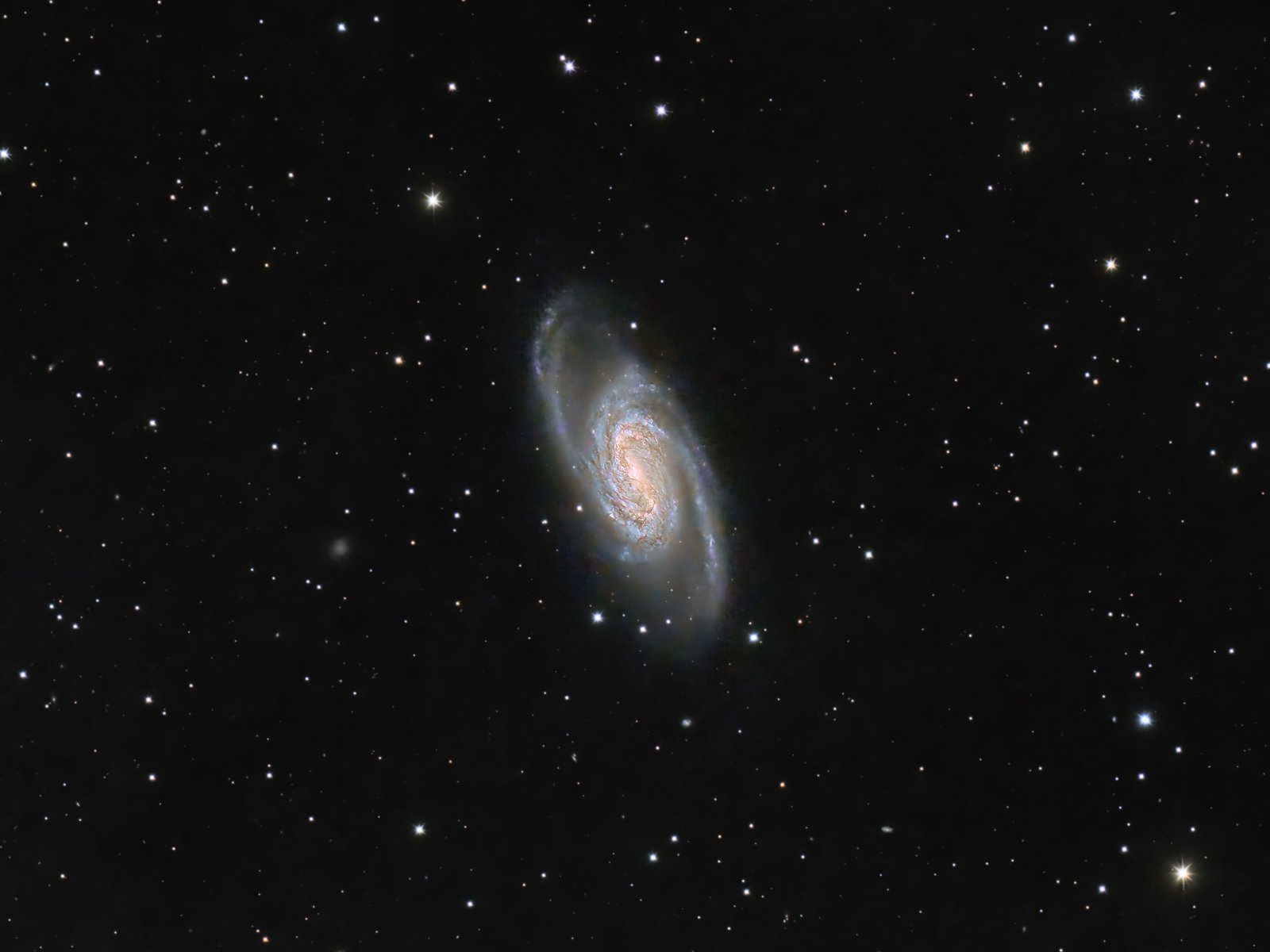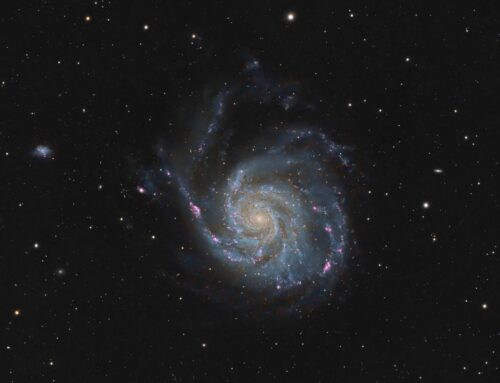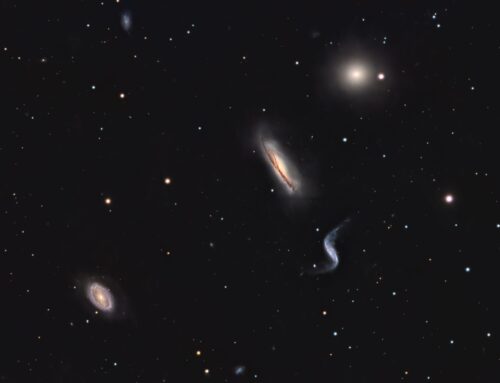NGC 2903

Click image for full size version
February 5, 2023
This is NGC 2903, a barred spiral galaxy in western Leo lying about 30 million light years away. It is a little smaller than our Milky Way, at “only” 80,000 light years across. New stars are being formed rapidly in the central region of NGC 2903. Pink emission nebula and blue star clusters are visible in the tightly wound arms near the centre. Several other galaxies are also visible in this field. The most prominent is 15th magnitude PGC 27115. By contrast, NGC 2903 has a visual magnitude of around 9, which is more than 200x brighter than its little neighbour.
This image was captured in a 4-hour window of clear skies in January 2023 using two scopes. It’s the only clear night I’ve had since late October 2022. I will come back to acquire more data on this object if the weather permits.
Tekkies:
Acquisition, focusing, and control of Paramount MX mount with N.I.N.A., TheSkyX; unguided. Focus with Optec DirectSync motors and controller. Equipment control with PrimaLuce Labs Eagle 4 Pro computer. All pre-processing and processing in PixInsight. Acquired from my SkyShed in Guelph. Good transparency and seeing. Acquired January 14, 2023 under a moon-free sky.
Sky-Watcher Esprit 150 f/7 refractor and QHY600M camera with Optolong UV/IR and 3nm H-alpha filters
Tak FSQ-106 @ f/5 (530mm), QHY-367C Pro One-shot colour, Optolong UV/IR filter
18x5m Ha = 1hr30m
43x5m OSC = 3hr55m
Preprocessing: The WeightedBatchPreProcessing script was used to perform calibration, cosmetic correction, weighting, registration, local normalization and integration of all frames.
Alignment of Master Frames: DrizzleIntegration was applied to the OSC frames (within WeightedBatchPreProcessing), and the result was aligned to the Luminance master with StarAlignment. This yielded aligned Ha, Lum and Colour masters.
Gradient Removal: DynamicBackgroundExtraction was applied to the three masters.
Colour Calibration: ColorCalibration was used to calibrate the OSC master.
Deconvolution: BlurXterminator was used on each master with a custom psf FWHM determined with the PSFImage script, and star sharpening set to 0.08.
Linear Noise Reduction: NoiseXterminator was applied to each image with settings Amount=0.9 and Detail=0
Stretching: HistogramTransformation was applied to each image to make a pleasing yet bright image.
Combining Luminance, Colour and H-alpha Images
Luminance addition: LRGBCombination was applied to replace the lightness of the RGB image with the Luminance master.
H-alpha Blending: The NBRGBCombination script was used to create a new image that blended the Ha into the LRGB. The resulting image was used to replace the core of the galaxy through a mask.
Additional Processing
Star Removal: StarXterminator was used to remove the stars.
Nonlinear Noise Reduction: NoiseXterminator was used to reduce noise in the background areas of the image with settings Amount=0.9 and Detail=0.3
Contrast Enhancement: LocalHistogramEqualization was applied three times using an inverted lightness mask to protect the background and select the galaxy. A Contrast Limit of 1.5 and 1 iteration were used for each application (scale 40, strength 0.25; scale 100, strength 0.25; and scale 150, strength 0.18).
Sharpening: MultiscaleMedianTransform was used to sharpen Layers 1 – 5 with strengths of 0.03, 0.05, 0.05, 0.04, and 0.03, respectively. Then, the outer arms were sharpened using a mask with Layers 5 and R with strengths of 0.1 and 0.02.
Star Restoration: Stars removed using StarXterminator were added back into the image using straight addition in PixelMath. The star image was used as a mask to shrink the stars slightly using MorphologicalTransformation (morphological selection mode, selection=0.11, strength =0.5, star shape 5×5 round).
Final Steps: SCNR was applied (Green; average neutral, 100%) to the outer arms of the galaxy using a mask to protect the rest of the image. Background, galaxy and star brightness, contrast and saturation were adjusted in several iterations using CurvesTransformation with masks as required. ICCProfileTransformation (sRGB IEC61966-2.1; Relative Colorimetric with black point compensation) was applied prior to saving as a jpg.







Gorgeous image, like always!
Love it Ron! Congrats!
Ron,
Outstanding astrophotography – Have you ever thought about selling astronomy cards like sports stores sell baseball, and football cards? I believe our youth would have an interest in this area and could generate some additional money for you on your web site.